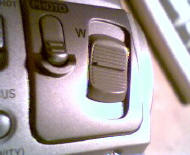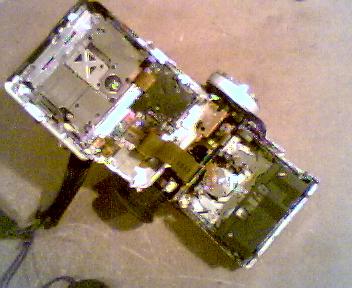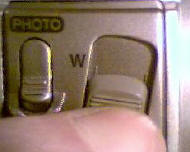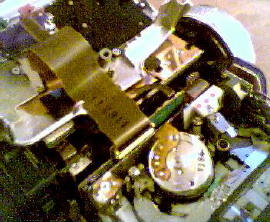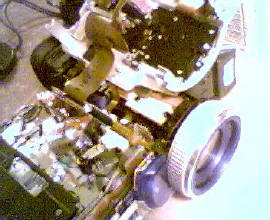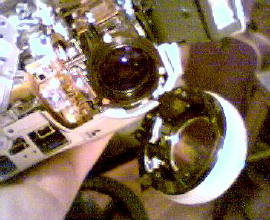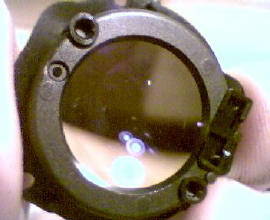Introduction
In my PC110 review on page 3 under Manual Control
Possibilities I commented on the Sony's zoom slider. To quote from
the article:
"Zooming is achieved via a very small
sliding tab. This control is progressive and provides for some extremely
fine speed variation, however, it is really too small and does not have
enough throw to enable smooth adjustment during capture. The result is
that no matter how careful you are, you can still always spot the zoom
jerking on and off.
To make matters worse, after a few weeks of use, my one has become a tad
sticky and this make it impossible to begin zooming slowly and smoothly.
I'll be able to deal with this with some minor cleaning, but it really is
a result of the slider's design. It has raised bearing surfaces to
minimize contact area, but in the end, plastic against plastic just
doesn't hack it."
Now, the same thing has happened to a DTV forum member. His post can be seen here.
I ended up rambling on about bearings and lube and even pulled my camera apart before realizing that I didn't really even have a solution to the problem. Why I then go ahead and put it here I'll never know :)
A bit about bearings first
A bearing is not a little metal ball. A bearing is
any area where surfaces interact. The surfaces 'bear' on each other. The
trick to making a smooth bearing (this goes for everything from zoom
sliders to engine pistons) is to use differing materials. That way, the
harder material will always wear away the softer one and they will not try
and fuse together from the heat and friction.
The point of lubricant is to insert little particles in-between the
surfaces to try and keep them from even touching each other. Think of all
lubricants from graphite powder to engine oil as nothing more than
millions of tiny ball-bearings.
And then the item at issue here
With the Sony slider, the designers have tried to go one step better than nothing and that is, minimize the area of the bearing surface. If you push the slider to one end and look closely, you'll see that it is not resting flat against the body, but is riding on a couple of little ridges. The logic being, less surface area = less friction = smoother operation. This is true, but only down to a particular level of friction. There will always be a certain point at which the slider jumps from being stationary to moving along the surface. Because the zoom action actually begins to operate somewhere around that same point, we have trouble avoiding a jerky take-up.
The only way for this bearing to run smoothly is for it to be 100% clean, not worn, dry and undamaged or, if that is not possible (because the camera is more than one day old).... to be lubed with something that smoothes over the wear and dirt.
Ideally we would be able to snap off the slider and clean it off with some alcohol on a cotton bud. Because we can't well have to try something else.
I decided I'd finally do something I've been meaning to do for a while and pull my camera apart. First impetus for this action has always been the zoom slider, but more recently some bits of dust or flakes of something else have found their way into my lens just behind the first group.
Of course, I would not be able to use my camera to take snaps of what I was doing so I tried using my crummy old Logitech web cam instead. The results are here:
|
|
||||
|
|
|
||||
|
|
So, what was the result of all that?
I was not able to do anything useful to the zoom slider because it is sealed inside a plastic unit made up from the black part pointed to above and the external dark grey plastic piece that the zoom slider is mounted in. These two parts are place together and then plastic rivets are melted to hold them in place. I was not able to get it apart without actually breaking the seals.
Can the slider be lubricated?
Chances are, it already is well lubed from your own body oils. This probably helps, but is not enough to break the jump-start effect. Should we add more lube? If I were doing an important shoot for good money, I'd probably try the tiniest amount of a suitable lube on each rail. Tiny means just enough to get the rails wet, not so much that it is all over the flat area. After the job I'd wipe it off again because it will only serve to attract more dirt and grime and just make the problem worse. A suitable lube is something thick-ish that does not damage plastic. I'd suggest a tube of heavy silicon lubricant as used for marine or outdoor applications. Anything light will not guarantee the proper results and anything petroleum based may just cause damage. The most important thing is to be use just the tiniest amount.
Can I learn to operate the slider better?
Yep. experiment with it. You may find that you are able to
improve your zooming by simply changing the way you use the lever.
The general idea is that you want to push the slider rather than press it
and then shift it along. Therefore, if you can get your finger-tip
or your nail (perhaps even the nail from your left hand from over the top
of the camera when you want to slide it the other way) into the slot with
the slider and then slowly apply pressure to the area in order to get the
zoom moving.
This is the method I use and it's not bad.
What else Rob!
ummm... you could try using the remote? The remote zoom function starts and stops far too quickly, but this sort of speed just might suit the action. Sometimes it is correct to zoom fast and sure. Professional camera operators are able to zoom at just about any speed and keep it looking natural. On both sides of the camera, timing is the key. Making it look natural is the desired effect and that can often mean quick and sharp focal length changes. Watch TV adverts and movies closely and follow exactly what the cameraman is doing.
Walk, don't zoom!
'Nuff said... don't zoom. One of the important steps in learning to 'see' as a visual artist is learning how to use and apply all technical aspects of vision. Angle of view, perspective and how they change over time are all just components of the same result... that of the final image.
Here's a quick lesson I like to use to talk myself out of taking a pile of lenses with me when I'm out hunting for photographs. Every scene ever seen (like that?)... can be photographed with any lens and get much the same results. The skill is in getting the image given whatever lens you have. At its most basic, look at it like this: Say you have a tree and a cow and a pond... and you want to have them all in your picture. If you only have a wide angle lens with you, you might do the obvious and just take the picture.. perhaps stepping back until you can get all three items near each other in the frame.
What if you only have a telephoto lens? The trick here is to move around looking for a particular angle of view that will include all items in a tasty manner. It might be nice to have a view of the pond through the branches of the tree with the cow visible in the background. You will now be trying to line the three subjects up one after the other, perhaps even overlapping slightly.... in fact, something may even end up being out of focus.
All of this can be achieved without resorting to zooming. Next time we're out with our DVCams, let's decide in advance on a suitable focal length for our video and then stick to it.
Can there possibly be any more to this extraordinarily minor issue?!?
Of course :)) The final possibility for controlling the PC110 zoom better might be through the LANC connection. This little socket that all Sony video equipment has is some sort of serial interface to the camera functions. Sony makes a video tripod with a head that has camera controls mounted on the handle. I haven't used it myself, but I'm sure there must be a gadget that plugs in there that will allow for better zoom control. I'll certainly post anything I find about that.
That's about it. A lot of thoughts on one of those minor problems that everything ever made seems to suffer from. In the end, these things determine how we use the equipment and surprisingly these 'bugs' can sometimes become highly desirable 'features'. A case in point is the old plastic Diana camera.. one hell of a crappy lens made for one hot art-school camera. Who knows, maybe the jerky zoom slider will do no more than irritate some and educate others.
Catch u all
Rob
